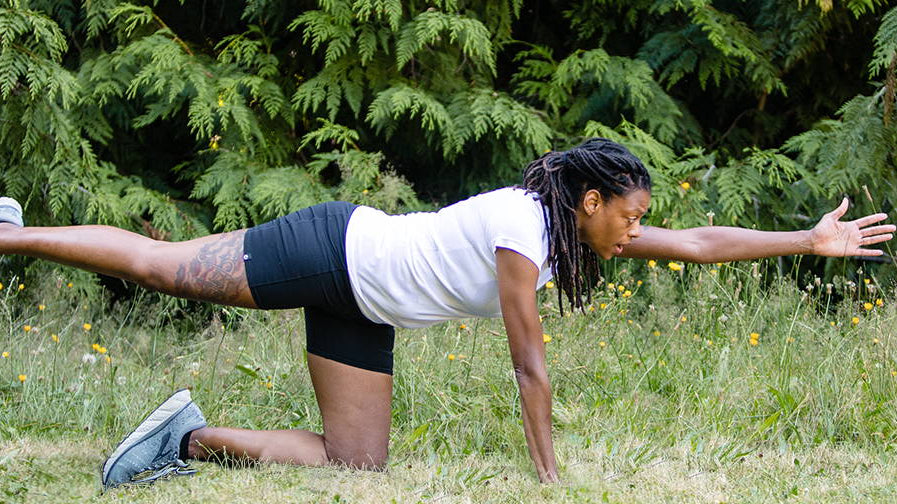By: Nancy Boyd, PT, DPT, FAFS
Nancy is a women’s health specialist, fellow of applied functional science, and USAT Level 1 Triathlon Coach. She is passionate about educating the public that, while common, incontinence and pelvic pain are not normal and physical therapy can be invaluable. If you have any questions on women’s health physical therapy, Nancy is here to help at nancy@realrehab.com.
Fall is here and the perfect running temperatures, crisp air, and beautiful scenery make it an ideal time for running and racing. For new moms who had babies over the summer, many are itching to get back to the roads and to achieve their pre-pregnancy fitness levels. Most moms are given the all-clear to return to running and gradually build up their mileage at their 6-week check-ups and some are given clearance even earlier if they had uncomplicated deliveries and remained active throughout their pregnancies. Unfortunately, guidelines for returning to running are very vague and dysfunctions in the pelvic floor and core are often overlooked or considered a normal response to childbirth.
Due to the changes that occur, pregnancy is often the time that pelvic floor muscle weakness begins. During pregnancy, hormonal changes lead to increased laxity in the ligaments. This change, coupled with the increased load of a growing infant, leads to an increase in motion in your low back and pelvis. A lack of strength or muscular endurance in the body’s ability to control this extra motion three-dimensionally can lead to injury. Research has shown that these changes often persist after childbirth and that running gait during and after pregnancy changes (Nissenbaum et al 2012).
Understanding Your Pelvic Floor as a Three-Dimensional System
The pelvic floor musculature can be viewed as the base of our core, which provides support to a large system designed to react and transfer forces from our upper to lower extremities and vice versa. The front of the core is comprised of your abdominals, the back is composed of the hip and back musculature, and the top is the respiratory diaphragm. All of these muscles are covered by a thin layer of connective tissue called fascia, which surrounds individual muscles and connects groups of muscles together. Due to these connections, dysfunction in any one of these places can cause a problem in another part of the system. “The diaphragm is fascially connected to the core and loads the anterior and posterior walls elevating and depressing the roof from the top and the pelvic floor from the bottom “ (Christie & Colosi 2009). Our core must be activated through all three dimensions – the sagittal (forward and backward), frontal (side to side), and transverse (rotational) planes – in order to properly load and strengthen the pelvic floor so that these tissues can work successfully to provide support during dynamic movements such as running. Just as the pelvic floor can be loaded from above, it also can be loaded from below due to its fascial attachment to the hips, especially the hip rotators (located under your gluteals) and adductors (inner thigh). These muscles must be able to be lengthened and loaded symmetrically in all three dimensions in order to stimulate similar lengthening and loading to the muscles of the pelvic floor.
You can think of the three-dimensional core like a pop can: If you puncture the can anywhere, the pressure of the system is compromised. After childbirth, many women develop dysfunctions in one or more areas of this three-dimensional system. For example, many women can develop an overstretching or tearing of the pelvic floor musculature or a splitting of the abdominal muscles at their tendonous attachment at the midline of the body known as diastasis recti. These changes compromise the ability of the core to “turn on” automatically, which leads to a loss of support for the entire body. As many as one in three women suffer from pelvic pain, incontinence, low back pain, or hip pain as a result of this loss of function in one of the components of the three-dimensional core, oftentimes the pelvic floor. These symptoms are not a normal result of childbirth and should not be dealt with for any length of time. Three-dimensional training of the entire core is one possible solution to rebooting the system and restoring the automatic stability of the pelvic floor system.
Start Training Your Pelvic Floor in 3-D
Here are some sample exercises to help reintegrate automatic activation of the three-dimensional core and get you back to running healthy and strong!
1. Bridging with Hip Rotation

With this exercise you are able to take advantage of the pelvic floor’s connection to the hip rotators and can activate the system from below. Start with your knees together, which will create hip internal rotation, and as you bridge up, pull your knees apart. As this becomes easier, you can add a resistance band to increase the load.
2. Plank with Hip Drivers and Ball Squeeze

With this exercise you are able to take advantage of the pelvic floor’s connection to the inner thigh muscles known as the adductors, by squeezing a ball as your hips lower into a plank position. On hands and feet, you are able to lengthen and shorten the abdominals to once again stimulate the muscles of the pelvic floor.
3. Multiplane lunges with Overhead Reach

With this exercise you are able to take advantage of the pelvic floor’s connection to the abdominals. Raise your arms up and overhead as you lunge to eccentrically lengthen and load the abdominals.
4. Lunge with Cross Body Reach

Here you are able to put all of the pieces together and do an exercise that will stimulate activation of the core as you do in running. Be sure to push through your foot and get as tall as you can as you come to stand and rotate your torso towards the balancing leg while staying as tall as you can to avoid over-rotating through your low back.
Kegels are Not Enough!
A healthy pelvic floor must be both strong and flexible. Unfortunately, a one-exercise-fits-all kegel – conscious isolated contraction in which the pelvic floor muscles are lifted up and in – is most often prescribed. Kegels can be helpful in certain situations to identify and create mind-body awareness around a muscle group that needs to be strengthened; however, they are often performed incorrectly, are not training the muscles to load functionally as part of a three-dimensional system, and may even be counterproductive depending upon the root cause of the issues.
Bladder control and pelvic stability should not have to be something that you think about. When toddlers go through potty training, muscles of their pelvic floor are strengthened as they begin to move more by rolling, squatting, crawling, creeping, and walking to ultimately help gain control of their bladder function. It is through three-dimensional movements such as these that we can help women restore control of their pelvic floor musculature.
When to Seek Help
It is important to note that there are several causes for pelvic floor dysfunction and strengthening is not always the answer. Some women are unable to relax the muscles of their pelvic floor and have trigger points or scar tissue that need to be manually released. Others have muscle imbalances and flexibility issues that can lead to misalignments in the pelvis and can also cause pain. These situations are not normal and should not be dealt with for any length of time. As such, a proper physical therapy evaluation conducted by someone specializing in women’s health may be beneficial in helping to identify the root cause of your issues and helping you get back to running this fall stronger than ever.










